Desktop Llano Motherboards: The ASRock A75 Extreme6 Preview
by Ian Cutress on June 14, 2011 12:00 AM EST- Posted in
- Motherboards
- ASRock
- Llano
Test Bed
| Processor |
AMD A8-3850 APU with AMD Graphics 6550D 4 Cores, 4 Threads |
| Motherboards | A75 Extreme6 |
| Cooling | Corsair H50-1 Water Cooler |
| Power Supply | Silverstone 1000W 80 PLUS Silver |
| Memory |
Patriot Viper Extreme DDR3-2000 9-10-9-27 2x4GB Kit, 1.65V G.Skill RipjawsX DDR3-2133 9-11-9-28 4x4GB Kit, 1.65V |
| Memory Settings | DDR3-1333 9-9-9-24 1T 2x4GB |
| Video Cards |
XFX HD 5850 1GB Sapphire HD 5850 1GB |
| Video Drivers | Catalyst 10.12 |
| Hard Drive | Micron RealSSD C300 256GB |
| Optical Drive | LG GH22NS50 |
| Case | Open Test Bed—CoolerMaster Lab V1.0 |
| Operating System | Windows 7 64-bit |
| SATA Testing | Micron RealSSD C300 256GB |
| USB 2/3 Testing | Patriot 64GB SuperSonic USB 3.0 |
Results and Numbers
Most of the comparison data, as with many motherboard benchmark results, are usually CPU based—you won't see much in the way of variation for a lot of them. Here's a sneak peak at some of the more worthwhile ones:
Power Usage
The Desktop Llano system we're using, the A8-3850, is a 100W chip. Given that this is near in line with the 95W of the Sandy Bridge i5-2500K I've been using for the Cougar Point reviews, we can have an apples-to-apples comparison on power consumption against a Z68:
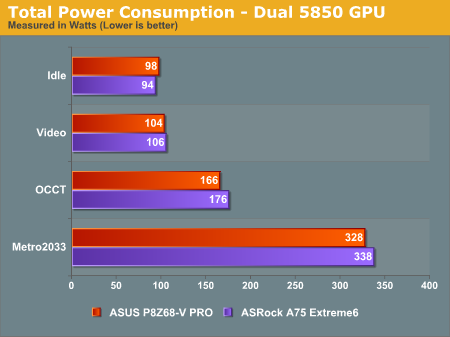
In terms of dual GPU usage, there's not much difference, though a 10W gap at high CPU usage with OCCT and Metro2033 for the A8-3850.
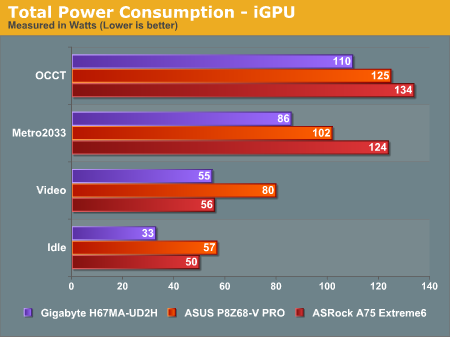
Compared to Z68, at low CPU conditions, the power of the A75 system is reasonable. However at high CPU conditions, or in general compared to the H67, we're using a lot of power here. Of course, Llano's iGPU is a significant step up in performance compared to Sandy Bridge, so we're not necessarily doing the same work here.
CPU Temperatures
Again, we have a prime opportunity for a comparison to Z68:
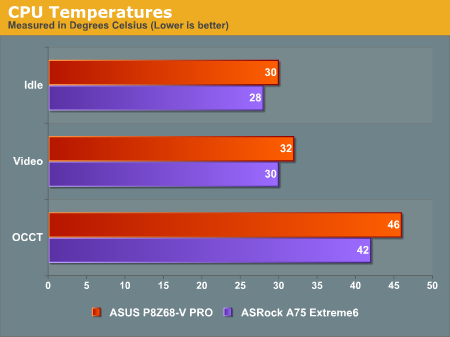
In each situation, using a Corsair H50, the A75 Extreme6 has a couple of degrees on the ASUS Z68.
USB Performance
Using CrystalDiskMark, we probe the sequential speeds of the USB 3.0 ports, then tackle the port with our standard motherboard copy test, consisting of 33 large and ~2100 small files, total size of 1.52 GB.

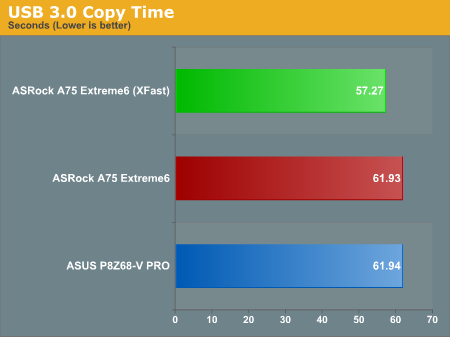
In terms of USB 3.0 copy time, we're not seeing much difference between the controller based Z68 and the native A75. ASRock's XFast is still providing a healthy increase in USB 3.0 speeds as well.
3D Movement Benchmark
In terms of pure CPU throughput, we're dealing with a quad core 2.9 GHz processor in our A8-3850 APU. Against the other processor families I have at my disposal:
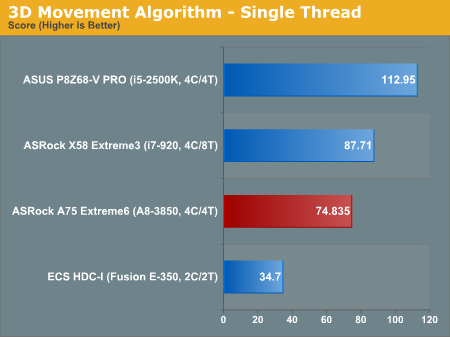
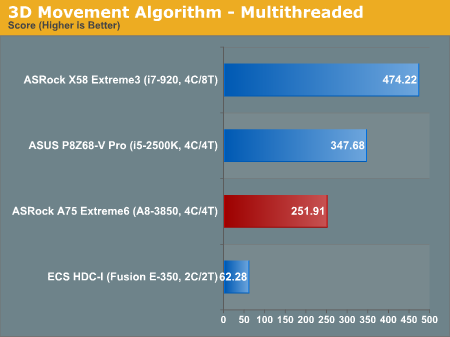
Even though AMD has a 2.9 GHz, 4C/4T CPU, it falls way behind the i5-2500K with the same number of threads. CPU performance is definitely mainstream in this regard.
iGPU
With the A8-3850, we're dealing with a 400 streaming processor model APU, the HD 6550D. Early web leaks led us to believe it's something special compared to Sandy Bridge offerings—I'm inclined to agree.
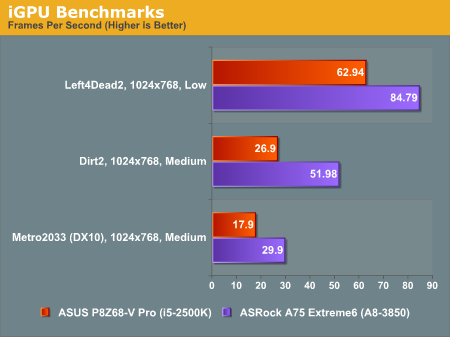










43 Comments
View All Comments
IanCutress - Tuesday, June 14, 2011 - link
Core i3 Second Generation chips are dual cores with hyperthreading (2C/4T). 2500K is 4C/4T. It's not a straight 50% as you make it out to be, otherwise the i7-920 (4C/8T) would act the same or worse than the 2500K (due to instructions per clock and clock speed).duploxxx - Tuesday, June 14, 2011 - link
it doesn't matter if you want to compare it to i3 or i5. If AMD puts a price on this Liano and it targets i3 then one should compare with i3, graphics performance there is nothing to compare against from Intel only discrete anyway.L. - Tuesday, June 14, 2011 - link
Although this battle looks a bit heated, I'll be joinin on the fun :pQuite seriously, Llano is not meant to be compared with anything else than SOC systems, and I believe as soon as we have pricing information, it'll be a clear winner.
i3 is still an "overpowered" CPU compared to most everyone's needs, with a clearly underpowered GPU compared to any basic gaming needs.
The good comparison for the Llano will be : xyz watts, zyx dollars for the base SOC system.
I believe anything like discrete graphics does not fall in the same category and would thus be nonsense, unless it falls in the extremely unlikely case of same tdp, same price and better performance, where it'll still have the big disadvantage of not being SOC.
Clearly any comparison with an i5 is purely informative, as the i5-2500k is an overkill CPU for (almost) everything and thus of limited interest to most customers (as in, drop that i5 and it's expensive mobo, drop the 6870, get a cheap phenom crap and an hd6950 and there you go, better results).
Quite curious as to how much the base combo with Llano will cost and consume, mini-ITX 4 gigs of RAM looks like plenty for that type of SoC.
jrs77 - Tuesday, June 14, 2011 - link
Llano seems to lack CPU-performance like we expected and excels in video-performance compared to SandyBridge.The question is, just how much video-performance Joe Black needs on a daily basis.
If Llano isn't way cheaper then intels i3-2xxx and doesn't use less power, then there's imho no reason to go for AMD. And intel can easily upgrade their small desktop-chips from HD2000 to HD3000 to improve the iGPU drastically.
I'm not impressed actually.
medi01 - Wednesday, June 15, 2011 - link
Did you take motherboard cost into account?I simply cannot imagine users that would benefit from a bit higher raw CPU performance CPU of i3 level more than from a vastly superior video/3D performance.
psychobriggsy - Tuesday, June 14, 2011 - link
Can you confirm why you are using Catalyst 10.12 in this day and age, when Llano requires 11.4 or higher? Or is that a cut-and-paste mistake?Also can you try using DDR-1833 with Llano next time - I don't know why you've downclocked the fast memory that is used in this preview - a limitation with the ES Llano you're using?
IanCutress - Tuesday, June 14, 2011 - link
Catalyst 10.12 was used for the discrete GPU results in the test, the drivers on the support CD were used for the iGPU tests. Using Catalyst 10.12 allows us to retain parity with the other products we've tested this year - particularly when improved Crossfire profiles are released, it would be unfair to compare similar products with wildly different Catalyst versions if the latest has a significant performance increase. Every time we change Catalyst versions, I will have to go back and test a few previous boards in order to have some comparison points for the future. That being said, we may move to 11.6 when it is released.Also the same thing with memory - in order to retain parity across systems, particularly H67 (or the fact that Cougar Point only officially supports DDR3-1333) for results. Otherwise they'll all be skewed depending on the vendors choice of memory support.
Ian
psychobriggsy - Tuesday, June 14, 2011 - link
I feel it is unfair to cripple a competitor because the other competitor can't do something. If Llano on the desktop officially supports DDR3-1600 and DDR3-1866 then it should be tested with them (and indeed would be an interesting small article - the effect of memory speeds on Llano performance) because it may support them for a reason (in this case the fGPU would benefit from higher memory bandwidth).In the other Llano article Anand was very happy to run off and retest with the latest Intel graphics drivers. It seems like there are two standards being applied.
muziqaz - Tuesday, June 14, 2011 - link
What's with the memory clock? Using hundreds of dollars worth of ram sticks just to downclock them to some 20 dollar stick levels?IanCutress - Tuesday, June 14, 2011 - link
As I've said in a previous comment, it is done in order to retain parity for the benchmarks across systems, particularly H67 (or the fact that Cougar Point only officially supports DDR3-1333). Otherwise they'll all be skewed depending on the vendors choice of memory support. Motherboards are tricky to test - you either go all out on all the settings, or try and level it out to real world use and keep the vast majority of settings consistent between products to find where the real differences are.Ian